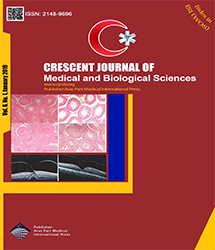
| Original Article | |
| Circadian Rhythms and Seasonal Incidence of Cardiac Arrhythmia in Cardiovascular Patients | |
| Mohsen Abbasnezhad1, Ahmad Separham1, Golnesa Shahnazarli2, Hossein Namdar1, Bahman Akhondi1 | |
| 1Department of Cardiology, Cardiovascular Research Center, Tabriz University of Medical Sciences, Tabriz, Iran 2Department of Midwifery, Faculty of Nursing and Midwifery, Tabriz University of Medical Sciences, Tabriz, Iran |
|
|
CJMB 2019; 6: 051-055 Viewed : 4150 times Downloaded : 2737 times. Keywords : Circadian rhythm, Seasonal incidence, Cardiac arrhythmia |
|
| Full Text(PDF) | Related Articles | |
| Abstract | |
Objectives: Cardiovascular diseases are one of the most common causes of inability and mortality in most countries. External and internal factors, especially circadian rhythms can play a significant role in the incidence of heart attacks and supraventricular arrhythmias. Various changes in the biological conditions of body lead to these rhythmic changes, as well as circadian cycles and seasonal incidence. The occurrence of cardiac arrhythmias fluctuates during the day and night. However, seasonal variations and night-time sleep are among the reasons for a decrease in the incidence of such arrhythmia. Materials and Methods: This study is descriptive research. The population of the study included patients who referred to the emergency room and inpatient centers of Shahid Madani teaching hospital of Tabriz. A total of 722 patients were examined during September 2008-2010. Data were analyzed using the SPSS, version 16. Results: Two types of arrhythmia including the atrial fibrillation (AF) and none-AF occurred in 480 (63%) and 292 (37%) individuals, respectively. In addition, as regards the seasonal distribution of arrhythmia, the highest incidence rate was 225 (29.1%) in spring. Further, in terms of the hour of incidence and the related percentage, arrhythmias were recorded during a circadian period and as follows: 00.00-4.00 (10. 2%), 4.00-8.00 (5.4%), 8.00-12.00 (34.9%), 12.00-16.00 (19.9%), 16.00-20.00 (16.5%), and 20.00-24.00 (12.6%). Conclusions:Generally, changes in seasonal circadian rhythms are believed to play a role in the incidence of supraventricular arrhythmic attacks. Furthermore, it is assumed that internal hormonal and biochemical changes affect the occurrence of supraventricular arrhythmia. Therefore, identifying these seasonal and circadian rhythms can have important practical applications. |
Cite By, Google Scholar
Google Scholar
PubMed
Online Submission System
 CJMB ENDNOTE ® Style
CJMB ENDNOTE ® Style
 Tutorials
Tutorials
 Publication Charge
Medical and Biological Research Center
About Journal
Publication Charge
Medical and Biological Research Center
About Journal
Aras Part Medical International Press Editor-in-Chief
Arash Khaki
Deputy Editor
Zafer Akan


















